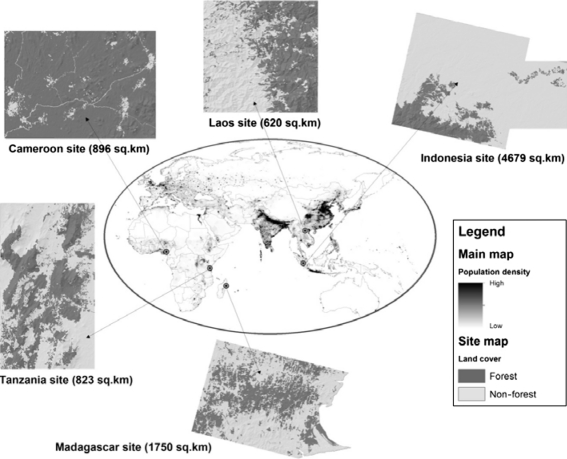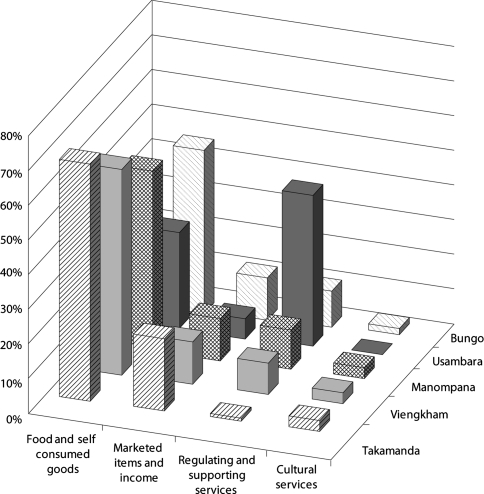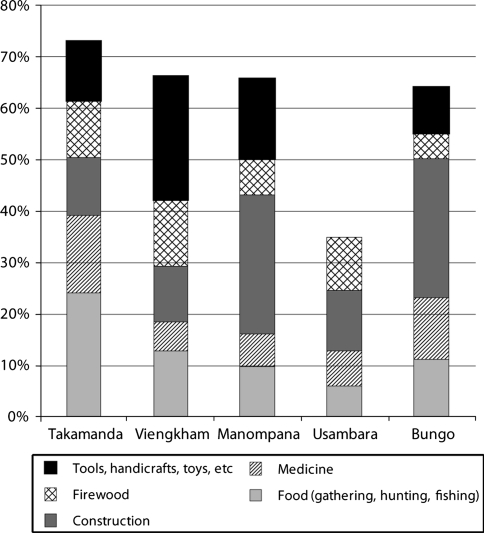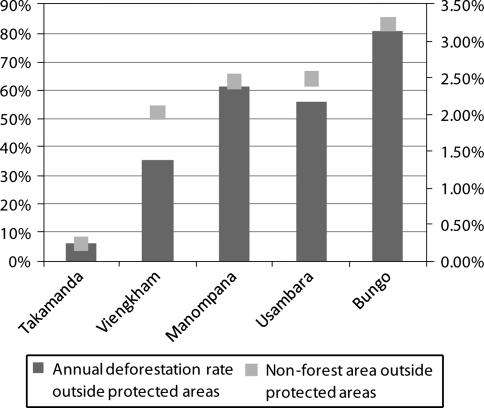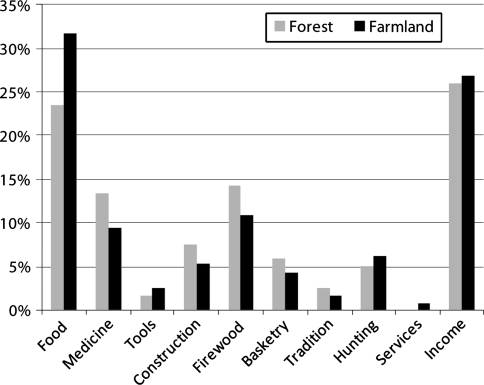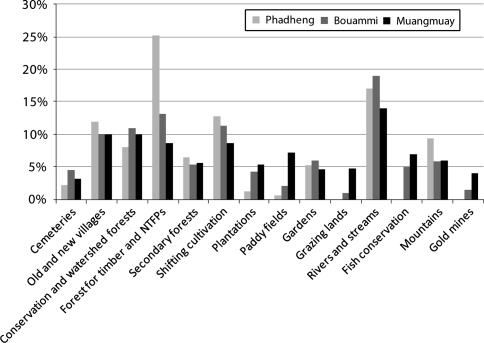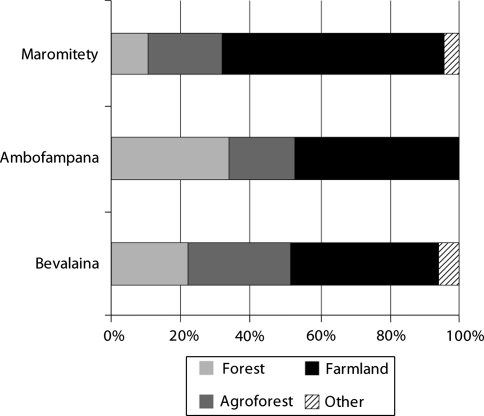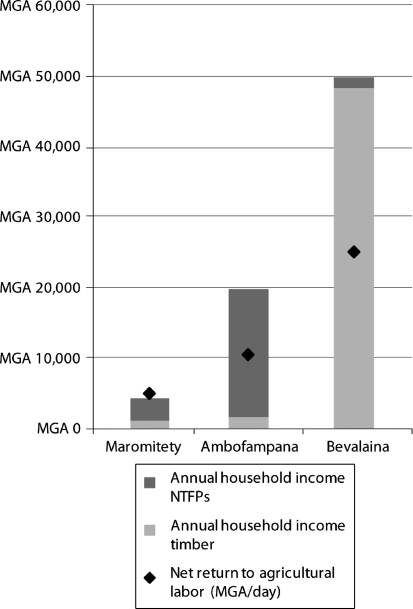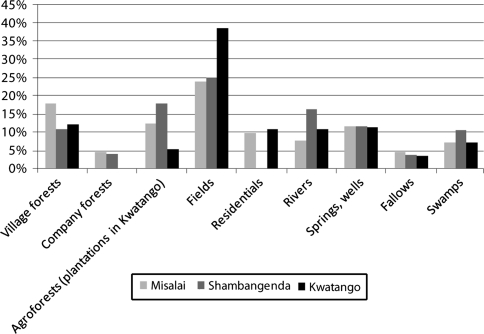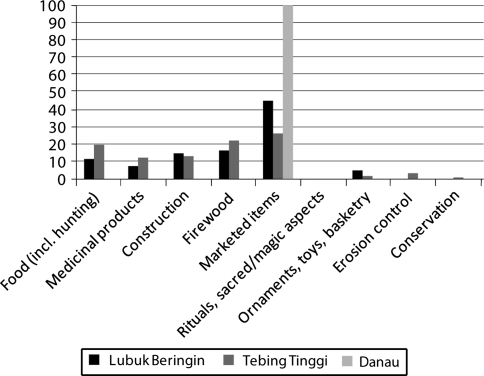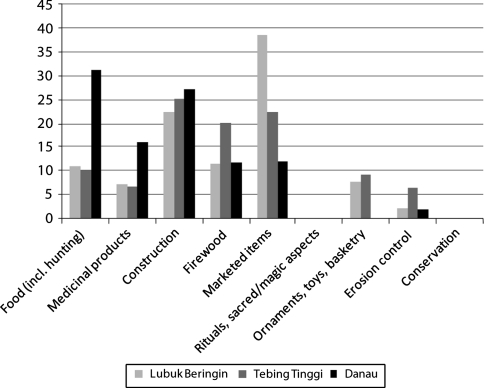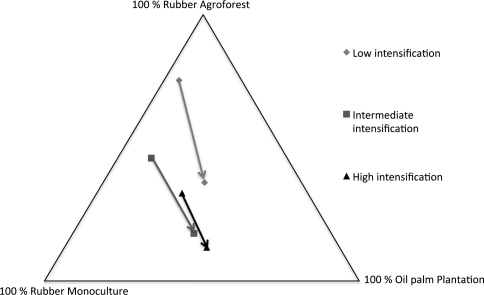Abstract
We examine five forested landscapes in Africa (Cameroon, Madagascar, and Tanzania) and Asia (Indonesia and Laos) at different stages of landscape change. In all five areas, forest cover (outside of protected areas) continues to decrease despite local people’s recognition of the importance of forest products and services. After forest conversion, agroforestry systems and fallows provide multiple functions and valued products, and retain significant biodiversity. But there are indications that such land use is transitory, with gradual simplification and loss of complex agroforests and fallows as land use becomes increasingly individualistic and profit driven. In Indonesia and Tanzania, farmers favor monocultures (rubber and oil palm, and sugarcane, respectively) for their high financial returns, with these systems replacing existing complex agroforests. In the study sites in Madagascar and Laos, investments in agroforests and new crops remain rare, despite government attempts to eradicate swidden systems and their multifunctional fallows. We discuss approaches to assessing local values related to landscape cover and associated goods and services. We highlight discrepancies between individual and collective responses in characterizing land use tendencies, and discuss the effects of accessibility on land management. We conclude that a combination of social, economic, and spatially explicit assessment methods is necessary to inform land use planning. Furthermore, any efforts to modify current trends will require clear incentives, such as through carbon finance. We speculate on the nature of such incentive schemes and the possibility of rewarding the provision of ecosystem services at a landscape scale and in a socially equitable manner.
Keywords: Landscape management, Local perceptions, Biodiversity conservation, Agroforestry
Introduction
Species-rich natural forests play a major role in human livelihoods and economic development in the humid tropics. They provide numerous products, goods, and services and, through their conversion, agricultural land (Nasi and others 2002). It is commonly assumed that rural, especially indigenous, people are more respectful of their environments than most other societies (Colchester 2000), but, in fact, people’s relationships with forests are diverse and dynamic (Rantala and Lyimo 2011; Woodcock 2002). Forest transition theory and related studies indicate common patterns in the long-term relationship between forest cover and societal development (Mather 1992; Rudel and others 2005). The basic assumption is that deforestation, driven by agricultural conversion, continues to a point until tree cover begins to increase again (Chomitz and others 2007). However, the generality of such transitions remains debated and uncertain, as causes and effects of deforestation are not uniform (Lambin and others 2001). Another point of interest is the level of biodiversity and ecosystem services that can be preserved during the transition (Chazdon and others 2009; Wright and Muller-Landau 2006).
Forest conversion does not equate to total tree loss. Some forest products and services are substituted or replaced by other land use systems. Agroforests, especially those allowing natural regeneration, can mitigate the trade-offs between biodiversity and other tree-based environmental functions and commodity production (Boffa and others 2005; Scales and Marsden 2008; Schroth and Harvey 2007). Shifting cultivation (swidden or “slash-and-burn”) can be viewed as a form of agroforestry in which trees and crops are intimately interspersed in time rather than space, and fallow vegetation may provide forest goods and services (Harwood 1996; Ramakrishnan 1992).
To determine how to maintain forests and their functions in dynamic landscapes, it is important to understand how local people value different types of land cover, and how these values relate to observed land use choices and trends. In this paper, we examine forest conversion processes in five dynamic tropical landscapes and analyze local perceptions of the landscape. Our goal is to clarify how local people view and value current tree-based land cover, and how such knowledge could be used to support sustainable landscape management schemes. We discuss how incentive schemes could be designed to reduce biodiversity loss in these landscapes.
Study Sites and Methods
Site Descriptions
The project operated in the following five tropical landscapes (Fig. 1), all of which include an official conservation area and other tree-based cover in the surrounding landscape:
Takamanda-Mone Technical Operations Unit, Southwest Region, Cameroon
Manompana corridor, Soanierana Ivongo District, Madagascar
Viengkham District, Luang Prabang Province, Laos
East Usambara Mountains, Tanga Region, Tanzania
Bungo District, Jambi Province, Indonesia
Fig. 1.
Locations of the five selected sites, and size and forest cover of each studied landscape
These sites represent a range of stages of forest cover and land change processes. At one end of the spectrum is the Cameroonian site, which is the most forested (94.4% forest, both dense and degraded natural forest; Dewi and Ekadinata 2010). However, forest conversion is being driven by cocoa plantations (Theobroma cacao) and other crop expansion combined with increasing market access. At the other end of the spectrum is the Indonesian site, which has experienced several decades of land use change and has approximately 17% natural forest cover remaining, mainly under protection. Table 1 summarizes the population densities, major commodities, policy contexts, livelihood systems, agroforests, and types of management in the five landscapes.
Table 1.
Population density, forest cover, and summaries of the main policy drivers, land and resource management systems, and market commodities in the five study landscapes
| Site | Population density (person/km2) | Natural forest cover of the study zone | Main policy drivers for conservation and development | Key elements of the resource management system | Main market commodities | Dominant agroforestry systems | Land use management type |
|---|---|---|---|---|---|---|---|
| Cameroon: Takamanda-Mone Technical Operation Unit | 10–30 | 94% (protected areas, forest reserves and concession, unallocated (forest)) | Ongoing land zoning including the recent creation of a national park, logging concession included in the Technical Operation Unit, road development | NTFP harvesting, fishing, hunting, cassava, cocoa timber | Cocoa, oil palm, timber, bush mango | Cocoa, bush mango, oil palm | Swidden agriculture, smallholder |
| Laos: Viengkham District | 20 | 48% (mostly in the protected area for the study zone) | Opium eradication, land use planning to counter shifting cultivation, conservation and forestry policies, village resettlement | Upland and paddy rice cultivation, NTFP harvesting, cattle, monocrop plantations | Rice, teak, pigeon pea | Shifting cultivation with fallows | Swidden agriculture, tree plantations, smallholder |
| Madagascar: Manompana corridor | 20 | 37% (mostly outside the protected area in the study zone) | Conservation and forestry policies, including devolution of management rights, and internationally funded projects, generally conservation-oriented | Upland rice cultivation, clove trees and homegardens, timber, zebu, poultry | Rice, cloves, coffee, vanilla | Shifting cultivation with fallows, mixed homegardens and clove and fruit trees, vanilla cultivation | Swidden agriculture, smallholder |
| Tanzania: East Usambaras | 90 | 36% (mostly protected) | Conservation and forestry policies, land allocation and land use planning | Maize, cassava, beans, spices, sugarcane, tea | Spices, sugarcane, tea | Cardamom agroforests, shifting cultivation | Smallholders with some industrial tea plantations |
| Indonesia: Bungo District | 35 | 17% (mostly protected) | Transmigration (large governmental agricultural colonization programs), forestry regulation, land use planning, agro-industrial concessions | Paddy rice, oil palm, rubber, fruit | Palm oil, rubber | Rubber and durian agroforests | Smallholder with strong industrial trends |
Methods
Working closely with local partners (state services, NGOs, and universities), we employed a variety of social, spatial, and ecological assessment methods (for more information, see http://www.biodiversityplatform.cgiar.org/_ref/projects/index.htm), following a predefined set of research tools and procedures (Pfund and others 2008). Within each of the five landscapes, we selected three settlements/communities (termed “villages”) and their surrounding territories. The sampled territories illustrate a gradient from more densely forested areas (close to the protected area and often with poor accessibility to markets) to less forested areas (further from the protected area, with easier market access).
Analysis of the Landscape Components’ Functions
To analyze the perceived importance of the current functions of the various landscape components, mainly defined by land use types, we used scoring exercises, based on the “Pebble Distribution Method” described in Sheil and others (2004; see also Lynam and others 2007; Sheil and Liswanti 2006). An example matrix (see Table 2 for a sample) was provided to project members and partners. The scoring exercise can be adapted according to local interests or research questions. It can be done either in rows (relative importance of functions by landscape component) or in columns (relative importance of landscape component by function); we conducted it by columns for forests and agroforests in all landscapes, and by rows for all functions. Land uses could be adapted to local contexts but functions were fixed to aid comparisons, with an “open” category included (for example, “provision of forage” was inserted for the Tanzanian case).
Table 2.
Basic matrix for field surveys, with landscape components forming the column headings, and functions or use categories the raw headings
| Forests | Fallows | Homegardens, agroforests | Tree plantations | Swamps | Agric. fields | Others | |
|---|---|---|---|---|---|---|---|
| 1. Food (incl. hunting) | |||||||
| 2. Medicinal products | |||||||
| 3. Construction | |||||||
| 4. Firewood | |||||||
| 5. Tools, basketry, etc. | |||||||
| 6. Marketed items | |||||||
| 7. Rituals, sacred/magic aspects | |||||||
| 8. Water services | |||||||
| 9. Conservation services | |||||||
| 10. Other |
In each village, residents were divided into focus groups according to gender, and in some cases further divided by age. In total, 45 groups were surveyed: six in Cameroon, 15 in Laos, six in Madagascar, 12 in Tanzania, and six in Indonesia. Examples were used to carefully explain the purpose and process of the exercise to the participants, who were given opportunities for questions and discussion. Landscape components were considered first; these were listed on large sheets of paper in the form of a matrix (and sometimes illustrated), along with the functions they might perform (Table 2).
The landscape components used varied across landscapes. Here, for ease of comparison and readability, we have grouped components into natural forests, permanent agroforests, fallows, and plantations. Note that we consider both dense and degraded but naturally regenerated mature forest as “natural forest,” which we refer to simply as “forest.” To distinguish temporary fallows from permanent agroforestry systems, we use the term “agroforests” to refer to tree-crop systems installed under forest cover or planted, while allowing wild, woody plant species to remain in the system. Focus group responses were averaged for each village; we do not discuss age or gender differences in this article.
Analysis of Past and Future Trends in Landscape Components and Uses
Spatial analyses relied on Landsat data (time-series analyses) and recent SPOT-5 images. We used images taken from the 1990s to 2009 for the time series, and from 2004 to 2009 for the most recent cover. We applied an object-based hierarchical classification (Definiens software), and land cover change analyses used post-classification comparisons (ArcGIS software). Deforestation rates were evaluated as the (linear) mean annual rate of change for two satellite images.
Visioning Exercises
We also used visioning exercises (Evans and others 2006), in which we asked focus group participants to draw and/or describe plausible future landscape scenarios (10–20 years ahead). These exercises stimulated discussion about how and why land use was changing and the wider implications of such changes.
Results
Local Perceptions of Forest Functions in All Sites
Participants’ responses were strikingly homogeneous across all focus groups, except those in Tanzania, highlighting the major importance of goods that forests provide for their direct uses (around 70% of the pebbles were allocated to self-consumed forest products), with very slight decreases in importance corresponding to lower forest cover of the sites (Fig. 2). In Tanzania, local communities considered environmental services (related to water and nature conservation) as the most important forest function.
Fig. 2.
Average importance given to self-consumed and marketed goods as well as to regulating/supporting and cultural services, aggregated by sites (Takamanda/Cameroon, Viengkham/Laos, Manompana/Madagascar, Usambara/Tanzania, Bungo/Indonesia)
Financial returns were rated the second most important aspect of natural forest (15–23%) for all communities, again with the exception of Tanzania, where they were rated third; the highest rating for financial returns was in Cameroonian villages. Regulating ecosystem services, mainly biodiversity and water conservation, were recognized in all sites, although weakly in Cameroon. Forest-related cultural services (sacred places, importance for rites and tradition) were of relatively minor importance in all sites. Almost equal importance was given to financial returns and regulating environmental services in Laos, Madagascar, and Indonesia, whereas in Cameroon, financial returns were clearly perceived as more important than regulating services.
Despite the homogeneity in the overall importance of self-consumed domestic uses of natural forests across sites, differences emerged in relation to the more specific uses and values involved (Fig. 3).
Fig. 3.
Relative importance given to specific categories of self-consumed goods, aggregated by sites
All general classes of products were recognized as important in each site (note that “tools” was not used in Tanzania). The importance of forest-derived food declines with diminishing forest cover; informants noted a decline in hunting (notably in Cameroon, Laos, and Madagascar) and a general change of diet to farm-based produce. Otherwise, patterns lack any clear correspondence to the decline of forest cover.
Deforestation Outside Protected Areas
The negative relationship between deforestation rate (outside protected areas) and remaining forest cover is striking, although unsurprising (Fig. 4). Despite recognition of their multiple and significant local values, forests are rapidly diminishing outside of protected areas. Our dataset indicates that the ratio of annual deforestation rate to the percentage of non-forest area in a given landscape is about 1:28 ± 5.
Fig. 4.
Annual deforestation rates outside protected areas from the 1990s through to 2000s (right axis) and the most recent percentage of non-forest area in the five landscapes (left axis)
In the following, we examine each of the sites more closely to understand into what land use types forests were converted, the perceived importance of other tree-based systems, and trajectories of change. We highlight variations in local perceptions between the villages in each case study.
Functions and Variability of Tree-Based Systems in the Studied Landscapes
Cameroonian site
Local stakeholders divided the Takamanda-Mone landscape into two main components: forests and farmlands. However, they did not clearly differentiate between the functions provided by forest or farmland areas (Fig. 5). On average, surveyed village communities valued both forests and farmlands for their food [collection of non-timber forest products (NTFPs), animal trapping] and direct income generation potential, although the importance given to farmlands for these major functions was more pronounced. Differences in scoring responses between villages were slight.
Fig. 5.
Average importance given to functions of forests and farmlands in Takamanda, Cameroon
Sources of income include trade of high-value NTFPs such as bush mango (Irvingia spp.), eru (Gnetum spp.), chewing sticks (Garcinia spp. and Massularia acuminata), and cattle stick (Carpolobia spp.) and, especially for villagers adjacent to logging concessions, commercial timber extraction. In farmlands, improved market access due to road construction has stimulated the cultivation of cocoa as a cash crop during the past 10 years. Cocoa farms (up to 3 ha) are sometimes mixed with banana (Musa acuminata) and plantain (Musa x paradisiaca), with up to 50% canopy cover for shade. In the studied landscape, farmers living close to the main road were the first to cultivate cocoa, with other villagers following suit progressively once connected by improved road systems. The expansion of cocoa agroforests is a marked trend and farmers consider accessible forests to be land available for conversion. With the creation of the Takamanda National Park and overexploitation of some NTFPs, residents believe that access to wild resources will be limited in the future (van Vliet 2010).
In this landscape, cocoa cultivation often takes place under shade trees, giving the overall structure similarities to natural forest (Slayback 2009). Drivers of deforestation and spatial differentiation are related to road access and cocoa markets but, overall, there is no sharp segregation between landscape components, and the measured deforestation rate remains low, at 0.1%/ha*year.
Lao site
The Viengkham District site includes the large Nam Et Phou Loey National Protected Area, which is surrounded by complex landscape mosaics resulting from long-established systems of shifting cultivation. Free grazing of livestock and collection of NTFPs (including fish and crabs) complement the traditional upland rice swidden system. Local people value remaining forests more for NTFPs than for timber and mentioned their utility for providing shelter and forage for livestock. There are no permanent agroforests. Smallholder plantations in this landscape are primarily fruit trees (orange, Citrus aurantium; pomelo, Citrus maxima; jackfruit, Artocarpus heterophyllus; mango, Mangifera indica) and trees linked to specific markets such as agarwood (Aquilaria crassna), teak (Tectona grandis), and rubber (Hevea brasiliensis). Complementary exercises showed that residents prioritize tree uses for income generation, but still value food production and timber.
In contrast to the Takamanda landscape, local communities recognize a greatly differentiated set of landscape components (Fig. 6). Villagers listed with details all components of their landscape together with their functions and status. They distinguished between types of natural forests (conservation, timber and firewood, watershed protection, secondary forests), agricultural zones (gardens, irrigated paddy fields, shifting cultivation areas, grazing lands), water management zones (rivers, streams, fish conservation areas), mineral resources (gold mines, mountains), and societal locations (old and new villages, cemetery).
Fig. 6.
Types and values of landscape components as scored by focus groups in three villages in Laos. Phadheng is remote: it is two hours on foot to the nearest dirt road, where Bouammi is located, and about three hours to the asphalt road that leads to Muangmuay
Forests appeared prominently in responses, especially when combining all the types listed in Fig. 6. Forest products remain available and are to some extent complemented by those from plantations and fallows. Rivers and streams form very important landscape components, equally or more important than agricultural components, principally because they provide fish and crabs for local diets.
As shown in Fig. 6, the three villages differ in terms of access and forest cover, in contrast to the homogeneous Cameroonian landscape. It is therefore interesting to focus on the observed gradient in the importance villages placed on different forest types: in Phadheng, the most remote village, villagers considered forests for timber and NTFPs to be much more important than conservation forests, whereas the value given to these two forest categories was more balanced in the other villages. Furthermore, we note an inverse trend between shifting cultivation and paddy fields across villages and a higher importance of plantations in the more accessible villages of Bouammi and Muangmuay.
Irrigated rice is becoming more important, but swidden agriculture remains the principal farming system by area, as irrigated paddy fields lie in valley bottoms and cover less than 5% of the area. This is despite government policy encouraging rapid rotational upland rice cultivation by using a three-year fallow as a strategy to concentrate the system. Although harvesting of wild NTFPs continues in forest areas, domestication (i.e., the managed cultivation of NTFPs) is increasing in deforested areas, with easy market access for some profitable products such as peuak meuak (Boehmeria malabarica). Accessibility (by road, track, or river) appeared to be the most important factor when choosing the location of the few smallholder plantations seen in our study villages. It seems likely, however, that the district will be increasingly affected by the high regional demand for rubber and teak (Vongkhamor and others 2007). Government policies encourage private investment in plantations, building on the trend that has already seen large areas of forest converted to rubber plantations in the north of the country (Shi 2008).
Malagasy site
In the Manompana site, as in Laos, the main farming system is traditional upland rice cultivation through swidden cycles (locally called tavy), with irrigated rice farming in valley bottoms where there is sufficient water. Forests are viewed primarily as available land for agricultural expansion. The area of fallows used in shifting cultivation occupies between 43% (Ambofampana, enclaved in the forest corridor) and about 60% of village territories. Fallows provide local people with a range of valued products and services: (in order of importance for our site) fibers, tools, ropes and woody items, food production, medicinal plants, construction materials, and firewood. Food production is included because vegetables are planted in the first years of fallows. Fallows also possess notable ritual and sacred values through the spiritual and cultural associations of the tavy cycle (Pfund 2000).
Agroforests, locally called tanimboly, occur either around the villages as homegardens or in more remote agricultural zones. In addition to common crops such as banana (Musa acuminata), coffee (Coffea robusta), and papaya (Carica papaya), tanimboly can include various fruit trees (lychee, Litchi chinensis; breadfruit, Artocarpus altilis; jackfruit, Artocarpus heterophyllus; coffee) and clove trees (Syzygium aromaticum). These generally diverse agroforests contribute primarily to food production. Crops and trees for income generation [mainly cloves, coffee, and vanilla (Vanilla planifolia)] tend to be planted in monoculture stands, which are then named simply for the principal crop (e.g., “alan’jirofo” for “clove forests”). However, investment means are limited for such plantations, which remain a risky activity for most people. Agricultural diversification has been slowed by poverty, the risk of cyclone damage, tenure insecurity, and poor market access across the whole landscape.
Local valuations show that farmlands are the most important landscape component in terms of income generation (Fig. 7), but that forests are valued for marketable timber and NTFPs, particularly mats made of Pandanus guillaumetii (Fedele and others forthcoming). Distance to the road inhibits timber commercialization because of high transportation costs, but this limitation can be balanced by NTFPs, which are lighter and easier to carry, even from the remote villages of Ambofampana and Maromitety. This explains why people in remote villages still value forests as an income-generating landscape component (Fig. 7).
Fig. 7.
Importance of income generation from landscape components in Manompana, Madagascar. The three villages differ in terms of accessibility: Bevalaina is less than 30 minutes from the main road on foot, Ambofampana is four hours, and Maromitety eight hours
In the site in Madagascar, we evaluated financial incomes generated by agricultural and forest products (Fig. 8). Communities living closer to roads obtain significantly better returns to agricultural work than do remote communities, a feature particularly influenced by cash crop production (Rakotoarison 2009). Accessibility is also correlated with more income generated from marketed forest resources, although this income contribution is minor (less than 1% for farmers) compared with agricultural benefits. Although forest cover is diminishing (especially in Bevalaina), timber is exploited as soon as it can be transported at an acceptable cost, as it generates greater benefits than do NTFPs (Urech and Sorg 2010). A comparison of Figs. 7 and 8 indicates that local people do consider income generation from forests to be important, even though cash returns are limited compared with agricultural products. This finding might be because focus group participants place value on potential—rather than actual—income generation, or that they appreciate the role of forest resources as safety nets for cash. In Maromitety, for instance, where poverty is severe, rice production is often sufficient for only six months, so that even small financial returns can be considered important. However, with limited available land, growing populations, and the restriction of investment in new crops and agroforests to accessible areas, the shifting cultivation system will expand at the expense of forest, especially in remote areas.
Fig. 8.
Annual income generated by forest products (timber and NTFPs) in the study villages of Madagascar. Maromitety is the most remote (eight hours from the main road on foot), Ambofampana is intermediate (four hours), and Bevalaina is the most accessible (30 minutes). Indicative net returns to agricultural labor on fields are given as a reference. 1000 MGA (Malagasy Ariary) are as high as about 0.5 USD
Tanzanian site
The Tanzanian site, which is close to the Amani Nature Reserve in the East Usambaras, differs from the other sites in several aspects. Its most notable characteristics are the high population density and the fact that the Eastern Arc forests generally form habitat islands surrounded by drier and non-forested areas. Many of the people living in these regions are relatively recent immigrants, and hence do not have a strong cultural link to wet forests. Major international and national conservation efforts have mainly focused on the forest ecosystems in the mountain areas. In this study site, forests are highly valued for the provision of environmental services, conservation functions, and, particularly, the protection of water quality and prevention of soil erosion. Most focus group participants acknowledged the problem of declining forest services, and several communities—with NGO support—have devised new village bylaws to protect the forest environment. Nevertheless, deforestation outside protected areas continued unabated from 1992 to 2008. Lack of trust between forest officials and local communities, complex forest laws and procedures, and limited knowledge of regulations inhibit many farmers from planting or retaining trees in their farm areas (for more details, see Rantala and Lyimo 2011).
Among the livelihood options supported by conservation and development programs, agroforestry has been presented as a promising alternative for conserving ecosystem services. By maintaining a forest-like structure, agroforestry systems can support endemic and threatened species, such as the long-billed tailorbird (Artisornis moreaui), which was recorded in an agroforest for the first time during our surveys. Agroforestry systems comprise planted spices such as black pepper (Piper nigrum), cardamom (Elettaria cardamomum), cinnamon (Cinnamomum zeylanicum), and cloves (Syzygium aromaticum) under a partially open (around 50%) rainforest canopy. These agroforests also often include food crops such as yam and banana. Typically, forest species are initially maintained alongside food and cash crops, but tree regeneration is later cut to maximize crop production.
People consider fields to be the most important landscape components (Fig. 9), followed by agroforests and forests, which received similar value ratings. Forests owned by tea plantation companies (“company forests”) are less valued than village forests, and plantations in Kwatango (grouped with agroforests in the graph) received a much lower value than agroforests in other villages. As in Laos, water-related areas (rivers, springs, swamps) are of major importance, and a rather logical opposite relationship exists between the values given to open fields and fallows.
Fig. 9.
Relative importance of the landscape components described in three villages in the East Usambaras, Tanzania. Misalai and Shambangenda are located in a mountain corridor area accessible by dirt road, and Kwatango is in a lower forested area, accessible by poor-quality dirt road
When soil fertility decreases, agroforests are typically converted to land uses with less forest because such uses have higher economic returns (Reyes and others 2009; Stocking and Perkin 1992). In collaboration with our study, Bullock and others (forthcoming) analyzed the profitability of various agricultural systems and found that sugarcane, cardamom agroforestry, and perennial spices are the most profitable of the currently practiced cropping systems based on a 13-year period, which is the estimated productive life of a cardamom agroforest. In general, farmers recognize that conversion to more open land uses will perpetuate the trend of declining tree cover. Furthermore, conversion to open fields and monocultures reduces biodiversity potential.
Indonesian site
Since the 1970s, Bungo District in Sumatra has been transformed by infrastructure developments, mining developments, and large-scale immigration. Between 1973 and 2004, forest cover decreased from 75 to 35% (Dewi and Ekadinata 2010). From 1950 through the 1980s, the main emphasis was on the establishment of rubber monocultures; during the past two decades, however, oil palm plantations have become dominant in the development strategy (Feintrenie and Levang 2009; Feintrenie and others 2010a). In the Bungo landscape, remaining natural forests are far from the study villages, fallows play only a very minor and localized role, and the dominant tree-based systems are oil palm and rubber monocultures.
Various oil palm production systems exist in Indonesia (Sheil and others 2009), and both large companies and smallholders own and manage the oil palm plantations in Bungo District (for more details, see Feintrenie and others 2010a).
The few remaining agroforests are dominated by rubber or durian (Durio zibethinus) mixed with two or three other fruit and/or timber species (Lehébel-Péron and others forthcoming).
The principal function of the young agroforests is cash generation from natural rubber production, although they are also valued for food (from fruit trees), construction materials, and firewood, except in Danau (Fig. 10).
Fig. 10.
Recognized functions of young agroforests in three villages in Bungo District, Indonesia. Lubuk Beringin is close to the forested area. Danau is close to the district capital and has the least forest cover and Tebing Tinggi is in between
Farmers in villages with very limited forest cover tend to place greater importance on the provision of construction materials from old agroforests (Fig. 11). In Danau, old agroforests, which are dominated by durian trees, are highly valued for their provision of fruit. Increasingly, some villagers use other secondary products from agroforests such as Parkia speciosa pods, nuts, rattan, and fruits for subsistence or as alternative sources of income during periods of economic stress. These findings may indicate that the importance of agroforests for providing forest goods is increasing in environments that have few forest resources, and hence in which forest goods are becoming rare, as well as in agricultural fields poor in natural resources.
Fig. 11.
Recognized functions of old agroforests in three villages in Bungo District, Indonesia. Lubuk Beringin village is close to the forested area. Danau is close to the district capital and has the least forest cover and Tebing Tinggi is in between
Nevertheless, financial considerations continue to dominate farmers’ perceptions (see also Feintrenie and others 2010b). Through visioning exercises and perception surveys, farmers indicated that the most common and desirable pathway to improved livelihoods was through oil palm plantations and rubber intensification. Most farmers expressed a desire to have around 40% of their non-irrigable lands dedicated to oil palm, 40% to rubber monoculture, and 20% to agroforests with fruit trees (see Fig. 12, adapted from Therville 2008; see also Therville and others forthcoming). Market demand for other crops in the district is limited. Although there are plans at the provincial level to introduce large-scale pulpwood plantations (Acacia mangium, Eucalyptus spp.), local residents have little knowledge of these developments and remain unaware of the associated implications.
Fig. 12.
Perceptions among Bungo residents of the proportions of the three main land uses in their village territory, at present (beginning of the arrows) and in 20 years (end of the arrows). Results were averaged and clustered in 3 categories of 4 villages, Lubuk Beringin is in the “low”, Tebing Tinggi in the “intermediate” and Danau in the high intensification category. Adapted from Therville 2008, based on a survey of 12 villages in Bungo District
Discussion
Limitations of the Method in Assessing and Comparing Local Perceptions of Landscape Components
Issues of Definition, Comparison, and Scope
Some challenges arise when comparing scores across sites because of inconsistent definitions of landscape components. When defining categories of local land uses, it is useful to clarify if and how more general definitions can be applied later. Standardized definitions are especially important for components such as “natural forests” that are linked to centralized decisions or funding mechanisms such as REDD + discussed further below (Putz and Sasaki 2009; van Noordwijk and Minang 2009). When local aspects such as tree composition, management, and cover permanence are clear, they can generally be linked to broader categories. However, for cross-site comparisons, it is important to pay attention to details to ensure correspondence between regions. In our case, an element given insufficient consideration was the role of water and wetlands as “landscape components”. It would have been more comprehensive to encourage focus group participants to consider in their evaluations all landscape components as well as animal, vegetation, mineral, and water resources. The same applies when constructing a comprehensive list of functions or use categories; in our case, it would have been useful to include forage and the provision of mineral resources in our set of goods. As for environmental services, on the one hand, such services should be related to systems and relationships that people recognize; on the other hand, it should be possible to classify them into comprehensive categories for comparison, such as in relation to water quality and availability, which proved to be important in our sites. This is especially important in view of promoting reward mechanisms. When applying such assessment methods generally, it is necessary to consider trade-offs between open exercises, which are useful for capturing local interpretations, and assessments designed to deliver results suitable for making comparisons that are then used to identify spatial or regional priorities.
Influence of Focus Group Surveys
Our data reveal an apparent, well-known paradox similar to the classic “tragedy of the commons” (Hardin 1968), in that many of the tree-based use systems that are lost and converted into less diverse systems have multiple and significant local values. The perceived importance of landscape functions reflects not only their actual value but also the degree to which the service is a public (lower value) or private (higher value) good (Swift and others 2004); functions that are more public tend to be replaced by a narrower set of functions that accrue benefits to specific users. The data we collected through focus groups illustrate a collective “ideal” perspective, influenced by group leaders, rather than individual decision bases. Although many focus group participants may regret the loss of forests, species-rich agroforests, and fallows, they are under pressure to increase their own financial income. The loss of environmental services is thus the result not of ignorance or neglect but of commercial and demographic pressures and the desire for improved individual prosperity. Conservation efforts in the East Usambaras meant the general trend linking private goods and low services was reversed in the Tanzanian site. Under new decentralized village structures, the “community” appropriated areas that had been privately held and managed according to private land use decisions and set these aside for conservation, with strict restrictions on use.
The assessment of collective appreciation of the functions of forests and other landscape components is useful for opening discussions about landscape management strategies. However, when seeking to maintain important functions, it is crucial to present hard evidence of the actual trends to allow realistic planning in the light of individual constraints and behavior.
Relativity of the Information
Results relate to site- and village-specific contexts and must be interpreted in that light. For example, communities in Madagascar and Indonesia value the provision of construction materials more highly because they have few alternative sources for these products (Fig. 3). Strict logging regulations and plantations probably influenced answers in Tanzania and Laos, and the presence of timber trees in farmlands would have influenced answers in Cameroon. In the case of Madagascar, the three sampled villages awarded similar importance values to the “income generation” of different landscape components (forests, agroforests, farms) although, in absolute terms, net forest-related cash benefits are much higher in the accessible village and are generally very low in all villages compared with agricultural returns. Because of the lack of means and access to markets, local communities, especially remote ones, have very limited opportunities to invest in cash crops or livestock. Hence, they value forest income more highly than might be expected due to limitations related to marketable crops and the perceived potential of forests as freely accessible resources. In Indonesia, where farmers focus on lucrative crops such as rubber and oil palm, the lack of forest goods influences perceptions of old agroforests. Here again, combining perception surveys with quantitative measurements would inform deeper discussion, both of the differences between the perceived and actual importance in a given location, and of how it is influenced by local circumstances.
Influences of Outside Actors, Before and During Surveys
The importance given to environmental services in the Tanzanian site appears to make it an outlier. We identified two possible reasons for the difference. First, until recently, a system of management dating back more than 100 years excluded local people from most extractive benefits (see Rantala and Lyimo 2011). Second, the surveys were conducted by representatives of a conservation NGO that had been active in the region for several years. Both these factors might have encouraged the local communities to emphasize conservation values. Local people values generally reflect a complex mixture of experience, assumptions, and knowledge that, in most cases, have been introduced to the village by “outsiders.” Furthermore, local communities may be selective in deciding what views they wish to report to researchers. We therefore need to acknowledge that potential bias may occur if local informants provide answers skewed toward those that they believe the researchers (or officials) want to hear or that might offer them some advantage. As engaging with local communities and understanding their aspirations is a requisite when addressing the trade-offs between conservation and development, especially in agricultural landscapes (Garcia and others 2010; Harvey and others 2008), such biases and pitfalls cannot be entirely avoided, although they may be mitigated by longer periods of engagement and careful cross-checking (Sheil and Wunder 2002). Furthermore, trade-offs between the effects of individualistic behavior on recognized common environmental services can be highlighted during land management and zoning negotiations through the combined use of “soft” (social, anthropological) and “hard” (economic, spatial) data.
Trends and Local Variations
Respondents in all study sites recognized the multifunctional values of forests through the combined provision of goods, income, and environmental services. As described above, forest cover has been declining in all sites, and other landscape components are generally becoming more specialized with regard to their functions and values. In the cocoa agroforests of the Cameroonian site or the cardamom agroforests of the East Usambaras in Tanzania, forest structure is maintained and tree-based systems provide local people with a range of functions similar to those of natural forest. In landscapes influenced by swidden systems, fallows are perceived as providing a rich diversity of goods and services, including valued services such as conservation that are otherwise associated primarily with forests. Nevertheless, fallows also appear to be declining in both extent and significance—a consequence of increasing population density and focus on a limited set of rentable commodities.
Can agroforests provide functions comparable to those of the dwindling forests and fallows? One problem is that income generation is viewed as the primary role of agroforests in all sites (except Madagascar), an objective that favors monocultures because of their larger financial returns. Agroforestry products are the principal sources of income in Cameroon (cocoa) and Indonesia (through remaining rubber agroforests), and the trend toward more productive monocultures is pronounced in Indonesia and Tanzania. In Tanzania, agroforestry is the first stage in a sequence of cropping systems that steadily reduces tree cover, as reduced soil fertility motivates farmers to shift toward open fields and monocultures that are more profitable. A specialization trend is also evident in Laos, but in regions changing more rapidly than the site selected for this study. In northern Laos, rubber plantations are replacing the dominant shifting cultivation system as a result of government policies; in this context, any non-swidden “agroforest stage” is being bypassed entirely as plantation monocultures expand.
Where they occur, agroforests of even limited diversity or tree monocultures are still associated with secondary roles and functions—primarily income generation, with auxiliary value as wood, food (sometimes indirectly through hunting or fishing), and environmental services, such as some perceived value for biodiversity conservation and water (with the exception of Eucalyptus stands in Tanzania). In the village of Danau (Indonesia), which is surrounded by oil palm plantations and rubber monocultures, income generation is no longer a priority function of old mixed agroforests; the provision of food and construction material is considered more important.
The trend of land use change observed in the selected landscapes generally follows the decreasing path in the transition theory curve, that is, continuous forest decline first associated with the expansion of new landholdings and then to increase yields per unit area of land. It would be premature, however, to suggest that such trends are inevitable. Rigg and Nattapoolwat (2001) consider that Thailand’s processes of “deagrarianization” have contributed to biodiversity-friendly trends. In Thailand and Costa Rica, two countries that have experienced rapid economic growth, Andam and others (2010) estimate that conservation and ecosystem protection have contributed to poverty reduction. In Nepal, the devolution of responsibility to effectively community-led activities appears to have been key in local forest recovery (Nagendra 2007). Furthermore, species-rich homegardens remain a key part of land use practices in the accessible and often densely populated farmlands of Java (Indonesia) and elsewhere.
Parallel to the trends observed in our cases, people continue to consider forests and, to a lesser extent, other tree-based systems as viable land use options and recognize the various services they provide. Once commercial resources such as timber and NTFP species become depleted, obviously the remaining tree-based systems will be the only sources of wood for household use and other tree-based goods. There are indications that, where forests and tree-based systems are accessible, their potential to provide regular and free goods and services for domestic consumption can assume greater importance than their land reserve or commercial functions. Given this, how can trends of declining forest and tree cover in remote areas of developing countries be reversed?
Implications for Sustainable Landscape Management: The Need for Incentives to Maintain Trees in Rural Landscapes
Our results show that local communities are aware of, and actively use, the multiple environmental services provided by forests and other tree-based systems. Nevertheless, in all our study landscapes, the potential income from alternative land management systems has led to specialization of land uses and forest conversion, suggesting that local communities’ desire for financial profits and individualization of land management are the main drivers of these trends.
Based on these observations, we believe that efforts to protect the environment in fast-changing landscapes such as those in our case studies need to go beyond awareness building to encompass incentives to compensate local people for the opportunity costs associated with conservation of environmental services. It will be necessary to negotiate the trade-offs between conservation and development, and improved management schemes will have to include tangible rewards if they are to gain acceptance.
We therefore recommend that incentive mechanisms be assessed, negotiated, and implemented at a decentralized, landscape scale (see Pfund 2010 for a review of the spatial extent usually considered in this context). A decentralized scale of assessment and negotiation is needed to highlight discrepancies between individual and collective objectives, needs, and constraints, and to discuss trade-offs. The landscape scale is important in order to consider spatial variations in relation to service delivery, threat of deforestation, accessibility, tenure insecurity, and poverty. As accessibility also generally influences the reach of governmental or project interventions, landscape-scale incentive mechanisms should extend to remote communities, which are often close to forests, and take into account their relationships with the people and institutions in rural centers or cities. In some cases, such as the Takamanda-Mone Technical Operation Unit, land and resource management institutions are specifically designed to bring stakeholders together and manage an entire landscape; however, where no such institutions are in place, attempts should be made to build decentralized negotiation platforms and link them to administrative units and policy processes (Fraser and others 2006).
REDD + (reducing emissions from deforestation and forest degradation and enhancing carbon sinks) implementation measures could, for instance, act as an umbrella mechanism for developing the required reward schemes. Such mechanisms would depend on the presence of:
a participatory process of land use planning to design a landscape with clear goals of preserving and restoring multifunctionality for local livelihoods and an accountable monitoring system to ensure this is acted on;
payments for environmental services (PES) arrangements to ensure local benefits for rendered services, trying to cover as many services as possible and needed (following the idea of financing multiple services; see Wunder and Wertz-Kanounnikoff 2009); and
“fair and transparent community-based institutions” (Ghazoul and others 2009, p. 1889). The presence or absence of community rights can have a significant impact on the management of a landscape, as highlighted by Akiefnawati and others (2010) for our Indonesian site, and Sunderland and others (2003) for Takamanda. Accountable landscape-level institutions and organizations (Armitage 2008; Dietz and others 2003) are necessary to ensure equitable governance of rural landscapes (Görg 2007; Watts and Colfer 2011).
Any reward scheme designed to better maintain forest and tree functions in development trends should be planned according to multiple dimensions: social (from individual to collective and outsiders’ values), spatial (with particular consideration of how accessibility influences ecological and economic opportunities and constraints), and sociopolitical. REDD + and related institutions could provide a platform to address multiple dimensions. Therefore, such mechanisms should be complemented by, and integrated into, a broader and coordinated development strategy. Priority policy areas to consider in conjunction with REDD + are access, tenure, and management rights over natural resources, safeguards for responsible trade and investment, and proactive mechanisms for equitable benefit sharing.
Conclusions
Landscape changes and local aspirations in the five tropical sites studied indicate a trend toward intensive monocultures accompanied by the ongoing demise of integrated tree-based systems outside of protected areas. Deforestation and landscape change continue despite local people’s recognition of the multiple values of forests and tree-based systems in their landscapes—and their land use strategies and visions for the future suggest these processes will continue. Private financial concerns drive farmers to sacrifice the public services provided by forests, fallows, and some agroforests. Farmers’ responses confirmed that current land use trends are still broadly characterized by deforestation and conversion of complex agroforestry systems into monocultures, but perception-based focus group surveys need to be complemented by hard data, including quantitative information.
As natural forest cover declines, the associated range of recognized contributions to local livelihoods also declines. Although fallows and, to a lesser extent, complex agroforests can replace many forest functions, farmers increasingly value simplified agroforests and plantations for income generation. Our results suggest that complex agroforests are generally a temporary, interim solution for mitigating and substituting for loss of natural forests. It appears that agroforests, including swidden systems, will be preserved only if incentives are adequate. There is also a need for strong landscape-level institutions to avoid losses of the “tragedy of the commons” type. Without these, the useful role of agroforests in mitigating trade-offs between conservation and development will be compromised by the prospect of more lucrative returns from intensive monocultures.
When planning modified landscape management, perception surveys are a valuable tool for starting to understand collective perceptions of the functions provided by various landscape components. Responses can also serve as a reference for a “collective ideal.” Household socioeconomic surveys provide complementary data on the direct uses, income from, and locations of landscape components. Combining types of assessment enables the linking of individual to “ideal” collective strategies. Planning for improved outcomes at a landscape scale requires both local participation and an understanding of the differences between individual and collective strategies and how to reconcile these. Given the great importance of financial drivers for local actors, it is crucial to study the potential of market-based mechanisms, such as PES, that can be linked to conservation. A landscape-level incentive mechanism, linked to a landscape-level institution and land use planning process, would be an effective way to achieve this.
Acknowledgments
This research is part of the project “Integrating Livelihoods and Multiple Biodiversity Values in Landscape Mosaics,” a joint research project of CIFOR and the World Agroforestry Centre, funded by the Swiss Agency for Development and Cooperation (SDC) with complementary support from the European Commission, the Ministry of Foreign Affairs of Finland, and the Australian and Dutch programs for Junior Professional Officers and Volunteers. Despite the number of co-authors, we could not include all the field partners that helped us gather the data presented here; we are very grateful to those in Cameroon (Stella Asaha and colleagues), Madagascar (Etienne Andriamampandry and colleagues), Tanzania (Emmanuel Lyimo and colleagues), Laos (Vongvilay Vongkamsao and colleagues), and Indonesia (Ratna Akeniawati and colleagues). We thank Goetz Schroth, Meine van Noordwijk, and three anonymous reviewers for their valuable comments on this article, Edith Johnson for her help in coordinating language editing, and Gideon Suharyanto for the formatting of figures.
Open Access
This article is distributed under the terms of the Creative Commons Attribution Noncommercial License which permits any noncommercial use, distribution, and reproduction in any medium, provided the original author(s) and source are credited.
Footnotes
An erratum to this article can be found at http://dx.doi.org/10.1007/s00267-011-9712-6
References
- Akiefnawati R, Villamor GB, Zulfikar F, Budisetiawan I, Mulyoutami E, Ayat A, van Noordwijk M (2010) Stewardship agreement to reduce emissions from deforestation and degradation (REDD): Lubuk Beringin’s hutan desa as the first village forest in Indonesia. World Agroforestry Centre Working Paper Series 102
- Andam KS, Ferraro PJ, Sims KRE, Healy A, Holland MB. Protected areas reduced poverty in Costa Rica and Thailand. PNAS. 2010;107:9996–10001. doi: 10.1073/pnas.0914177107. [DOI] [PMC free article] [PubMed] [Google Scholar]
- Armitage D. Governance and the commons in a multi-level world. International Journal of the Commons. 2008;2:7–32. [Google Scholar]
- Boffa JM, Turyomurugyendo L, Barnekow-Lilleso JP, Kindt R. Enhancing farm tree diversity as a means of conserving landscape-based biodiversity. Mountain Research and Development. 2005;25:212–217. doi: 10.1659/0276-4741(2005)025[0212:EFTDAA]2.0.CO;2. [DOI] [Google Scholar]
- Bullock R, Mithoefer D, Vihemaki H (forthcoming) A comparative financial analysis of conventional land uses and implications for the adoption of improved agroforestry in the East Usambaras, Tanzania. World Agroforestry Center Working Paper Series
- Chazdon RL, Peres CA, Dent D, Sheil D, Lugo AE, Lamb D, Stork NE, Miller S. The potential for species conservation in tropical secondary forests. Conservation Biology. 2009;23:1406–1417. doi: 10.1111/j.1523-1739.2009.01338.x. [DOI] [PubMed] [Google Scholar]
- Chomitz KM, Buys P, de Luca G, Thomas TS, Wertz-Kanounnikoff S. At loggerheads? Agricultural expansion, poverty reduction, and environment in the tropical forests. Washington: World Bank; 2007. [Google Scholar]
- Colchester M. Self-determination or environmental determinism for indigenous people in tropical forest conservation. Conservation Biology. 2000;14(5):1365–1367. doi: 10.1046/j.1523-1739.2000.00129.x. [DOI] [Google Scholar]
- Dewi S, Ekadinata A (2010) Landscape dynamics over time and space from ecological perspective. ICRAF Southeast Asia Working Paper Series 103
- Dietz T, Ostrom E, Stern PC. The struggle to govern the commons. Science. 2003;5652(302):1907–1912. doi: 10.1126/science.1091015. [DOI] [PubMed] [Google Scholar]
- Evans K, Velarde SJ, Prieto R, Rao SN, Sertzen S, Dávila K, Cronkleton P, de Jong W (2006) Field guide to the future: four ways for communities to think ahead. In: Bennett E, Zurek M (eds) Center for International Forestry Research (CIFOR), ASB, World Agroforestry Centre, Nairobi, Kenya, p 87. http://www.asb.cgiar.org/PDFwebdocs/Evans-et-al-2006-Field-guide-to-the-future.pdf. Accessed 7 Apr 2011
- Fedele G, Urech ZL, Rehnus M, Sorg J-P (forthcoming) Impact of women’s harvest practices on Pandanus guillaumetii in Madagascar’s lowland rainforests. Economic Botany. doi:10.1007/s12231-011-9157-0
- Feintrenie L, Levang P. Sumatra’s rubber agroforests: advent, rise and fall of a sustainable cropping system. Small-Scale Forestry. 2009;8:323–335. doi: 10.1007/s11842-009-9086-2. [DOI] [Google Scholar]
- Feintrenie L, Chong WK, Levang P. Why do farmers prefer oil palm? Lessons learnt from Bungo district, Indonesia. Small-Scale Forestry. 2010;9(3):379–396. doi: 10.1007/s11842-010-9122-2. [DOI] [Google Scholar]
- Feintrenie L, Schwarze S, Levang P (2010b) Are local people conservationists? Analysis of transition dynamics from agroforests to monoculture plantations in Indonesia. Ecology and Society 15(4):37. http://www.ecologyandsociety.org/vol15/iss4/art37/. Accessed 5 Apr 2011
- Fraser EDG, Dougill AJ, Mabee WE, Reed M, McAlpine P. Bottom up and top down: analysis of participatory processes for sustainability indicator identification as a pathway to community empowerment and sustainable environmental management. Journal of Environmental management. 2006;78:114–127. doi: 10.1016/j.jenvman.2005.04.009. [DOI] [PubMed] [Google Scholar]
- Garcia CA, Bhagwat SA, Ghazoul J, Nath CD, Nanaya KM, Kushalappa CG, Raghuramulu Y, Nasi R, Vaast P. Biodiversity conservation in agricultural landscapes: challenges and opportunities of coffee agroforests in the Western Ghats, India. Conservation Biology. 2010;24:479–488. doi: 10.1111/j.1523-1739.2009.01386.x. [DOI] [PubMed] [Google Scholar]
- Ghazoul J, Garcia C, Kushalappa CG. Landscape labeling: a concept for next-generation payment for ecosystem service schemes. Forest Ecology and Management. 2009;258:1889–1895. doi: 10.1016/j.foreco.2009.01.038. [DOI] [Google Scholar]
- Görg C. Landscape governance. The “politics of scale” and the “natural” conditions of places. Geoforum. 2007;38:954–966. doi: 10.1016/j.geoforum.2007.01.004. [DOI] [Google Scholar]
- Hardin G. The tragedy of the commons. Science. 1968;162:1243–1248. doi: 10.1126/science.162.3859.1243. [DOI] [PubMed] [Google Scholar]
- Harvey CA, Komar O, Chazdon R, Ferguson BG, Finegan B, Griffith DM, Martínez-Ramos M, Morales H, Nigh R, Soto-Pinto L, van Breugel M, Wishnie M. Integrating agricultural landscapes with biodiversity conservation in the Mesoamerican hotspot. Conservation Biology. 2008;22:8–15. doi: 10.1111/j.1523-1739.2007.00863.x. [DOI] [PubMed] [Google Scholar]
- Harwood RR. Development pathways towards sustainable system following slash-and-burn. Agriculture, Ecosystem and Environment. 1996;58:75–76. doi: 10.1016/0167-8809(95)00655-9. [DOI] [Google Scholar]
- Lambin EF, Turner BL, Geist HJ, Agbola SB, Angelsen A, Bruce JW, Coomes OT, Dirzo R, Fischer G, Folke C, George PS, Homewood K, Imbernon J, Leemans R, Li X, Moran EF, Mortimore M, Ramakrishnan PS, Richards JF, Skanes H, Steffen W, Stone GD, Svedin U, Veldkamp TA, Vogel C, Xu J. The causes of land-use and land-cover change: moving beyond the myths. Global Environmental Change. 2001;11:261–269. doi: 10.1016/S0959-3780(01)00007-3. [DOI] [Google Scholar]
- Lehébel-Péron A, Feintrenie L, Levang P (2011) Rubber agroforests’ profitability, the importance of secondary products. Forests, Trees and Livelihoods 20:69–84
- Lynam T, De Jong W, Sheil D, Kusumanto T, Evans K (2007) A review of tools for incorporating community knowledge, preferences, and values into decision making in natural resources management. Ecology and Society 12(1):5. http://www.ecologyandsociety.org/vol12/iss1/art5/. Accessed 5 Apr 2011
- Mather AS. The forest transition. Area. 1992;24:367–379. [Google Scholar]
- Nagendra H. Drivers of reforestation in human-dominated forests. PNAS. 2007;104:15218–15223. doi: 10.1073/pnas.0702319104. [DOI] [PMC free article] [PubMed] [Google Scholar]
- Nasi R, Wunder S, Campos JJ (2002) Forest ecosystem services: can they pay our way out of deforestation? Center for International Forestry Research (CIFOR), Bogor, Indonesia. http://www.cifor.cgiar.org/Knowledge/Publications/Detail?pid=1199. Accessed 30 Oct 2009
- Pfund, JL (2000) Culture sur brûlis et gestion des ressources naturelles: évolution et perspectives de trois terroirs ruraux du versant Est de Madagascar. PhD thesis, ETH Zurich
- Pfund JL. Landscape-scale research for conservation and development in the tropics: fighting persisting challenges. Current Opinion in Environmental Sustainability. 2010;2:117–126. doi: 10.1016/j.cosust.2010.03.002. [DOI] [Google Scholar]
- Pfund JL, Boffa JM, Koponen P, O’Connor T, Watts JD, Colfer CJP, Dewi S, van Noordwijk M, Shanley P, Swallow B with colleagues from CIFOR and ICRAF (2008) Integrating livelihoods and multiple biodiversity values in landscape mosaics. Research guidelines version 1: general section. http://www.biodiversityplatform.cgiar.org/Documents/LM%20Research%20Guidelines%20Version%201_2008.pdf. Accessed 5 Apr 2011
- Putz FE, Sasaki N. What is forest? Response to Guariguata et al. Conservation Letters. 2009;2:288–289. doi: 10.1111/j.1755-263X.2009.00076.x. [DOI] [Google Scholar]
- Rakotoarison HH (2009) Revenus ruraux et compensations pour services environnementaux. DEA Thesis, ESSA-Forêts, University of Antananarivo, Madagascar
- Ramakrishnan PS. Shifting agriculture and sustainable development: an interdisciplinary study from north-eastern India. UNESCO MAB Series. Paris/Park Ridge: UNESCO/The Parthenon Publishing Group; 1992. [Google Scholar]
- Rantala S, Lyimo E. Changing landscapes, transforming institutions: local management of natural resources in the East Usambara Mountains, Tanzania. In: Colfer C, Pfund J-L, editors. Collaborative governance of tropical landscapes. London: Earthscan; 2011. pp. 107–132. [Google Scholar]
- Reyes T, Quiroz R, Luukkanen O, de Mendiburu F. Spice crops agroforestry systems in the East Usambara Mountains, Tanzania: growth analysis. Agroforestry Systems. 2009;76:513–523. doi: 10.1007/s10457-009-9210-5. [DOI] [Google Scholar]
- Rigg J, Nattapoolwat S. Embracing the global in Thailand: activism and pragmatism in an era of de-agrarianisation. World Development. 2001;29:945–960. doi: 10.1016/S0305-750X(01)00021-3. [DOI] [Google Scholar]
- Rudel TK, Coomes OT, Moran E, Achard F, Angelsen A, Xu J, Lambin E. Forest transitions: towards a global understanding of land use change. Global Environmental Change. 2005;15:23–31. doi: 10.1016/j.gloenvcha.2004.11.001. [DOI] [Google Scholar]
- Scales BR, Marsden SJ. Biodiversity in small-scale tropical agroforests: a review of species richness and abundance shifts and the factors influencing them. Environmental Conservation. 2008;35:160–172. doi: 10.1017/S0376892908004840. [DOI] [Google Scholar]
- Schroth G, Harvey CA. Biodiversity conservation in cocoa production landscapes: an overview. Biodiversity Conservation. 2007;16:2237–2244. doi: 10.1007/s10531-007-9195-1. [DOI] [Google Scholar]
- Sheil D, Liswanti N. Scoring the importance of tropical forest landscapes with local people: patterns and insights. Environmental Management. 2006;38:126–136. doi: 10.1007/s00267-005-0092-7. [DOI] [PubMed] [Google Scholar]
- Sheil D, Wunder S (2002) The value of tropical forest to local communities: complications, caveats and cautions. Conservation Ecology 6(2):9. http://www.consecol.org/vol6/iss2/art9. Accessed 5 Apr 2011
- Sheil D, Puri R, Basuki I, van Heist M, Wan M, Liswanti N, Rukmiyati, Sardjono MA, Samsoedin I, Sidiyasa K, Chrisandini Permana E, Angi EM, Gatzweiler F, Johnson B, Wijaya A. Exploring biological diversity, environment and local people’s perspectives in forest landscapes. Bogor: Center for International Forestry Research (CIFOR), Ministry of Forestry and International Tropical Timber Organization (ITTO); 2004. [Google Scholar]
- Sheil D, Casson C, Meijaard E, van Noordwijk M, Gaskell J, Sunderland-Groves J, Wertz, K, Kanninen M (2009) The impacts and opportunities of oil palm in Southeast Asia: what do we know and what do we need to know? Occasional Paper No. 51. Center for International Forestry Research (CIFOR), Bogor, Indonesia
- Shi W. Rubber boom in Luang Namtha. A transnational perspective. Rural development in mountainous areas of northern Lao PDR (RDMA) Vientiane: German Technical Cooperation; 2008. [Google Scholar]
- Slayback D. Forest degradation in Takamanda National Park and Mone Forest Reserve 1986–2008. Bogor: Center for International Forestry Research (CIFOR); 2009. [Google Scholar]
- Stocking M, Perkin S. Conservation-with-development: an application of the concept in the Usambara Mountains, Tanzania. Transactions of the Institute of British Geographers New Series. 1992;17:337–349. doi: 10.2307/622884. [DOI] [Google Scholar]
- Sunderland TCH, Sunderland-Groves JL, Comiskey JA, Ayeni JSO, Mdaihli M. Future conservation and management of the Takamanda Forest Reserve, Cameroon. In: Comiskey JA, Sunderland TCH, Sunderland-Groves JL, editors. Takamanda: the biodiversity of an African rainforest, SI/MAB Series 8. Washington: Smithsonian Institution; 2003. pp. 181–182. [Google Scholar]
- Swift MJ, Izac A-MN, van Noordwijk M. Biodiversity and ecosystem services in agricultural landscapes—are we asking the right questions? Agriculture, Ecosystems and Environment. 2004;104:113–134. doi: 10.1016/j.agee.2004.01.013. [DOI] [Google Scholar]
- Therville C (2008) Dynamic of rubber agroforests conversion in Muara Bungo district (Jambi, Indonesia). Combination of spatial analysis and perception surveys. Master’s thesis, Montpellier University, Montpellier, France
- Therville C, Feintrenie L, Levang P (2011) Farmers’ perspectives about agroforests conversion to plantations in Sumatra. Lessons learnt from Bungo district (Jambi, Indonesia). Forests, Trees and Livelihoods 20:15–33
- Urech ZL, Sorg JP (2010) Taking into account local people’s livelihood systems for a better management of forest fragments Forest Landscapes and Global Change. In: Azevedo JC, Feliciano M, Castro J, Pinto MA (eds) New frontiers in management, conservation and restoration. Proceedings. Bragança, Portugal, IUFRO, pp 628–634
- van Noordwijk M, Minang PA. If we cannot define it, we cannot save it. ASB Policy Brief No. 15. Nairobi: ASB Partnership for the Tropical Forest Margins; 2009. [Google Scholar]
- van Vliet N (2010) Participatory vulnerability assessment in the context of conservation and development projects: a case study of local communities in Southwest Cameroon. Ecology and Society 15(2):6. http://www.ecologyandsociety.org/vol15/iss2/art6/. Accessed 5 Apr 2011
- Vongkhamor S, Phimmasen K, Silapeth B, Xayxomphou B, Petterson E (2007) Key issues in smallholder rubber planting in Oudomxay and Luang Prabang Provinces, Lao PDR. In: Fujita Y (ed) National Agriculture and Forestry Research Institute (NAFRI) and Upland Research and Capacity Development Programme, Vientiane, Lao PDR
- Watts JD, Colfer CJP. The governance of tropical forested landscapes. In: Colfer C, Pfund J-L, editors. Collaborative governance of tropical landscapes. London: Earthscan; 2011. pp. 35–54. [Google Scholar]
- Woodcock K. Changing roles in natural forest management. Stakeholders’ roles in the Eastern Arc Mountains, Tanzania. Burlington: Ashgate; 2002. [Google Scholar]
- Wright SJ, Muller-Landau HC. The future of tropical forest species. Biotropica. 2006;38:287–301. doi: 10.1111/j.1744-7429.2006.00154.x. [DOI] [Google Scholar]
- Wunder S, Wertz-Kanounnikoff S. Payments for ecosystem services: a new way of conserving biodiversity in forests. Journal of Sustainable Forestry. 2009;28:576–596. doi: 10.1080/10549810902905669. [DOI] [Google Scholar]



